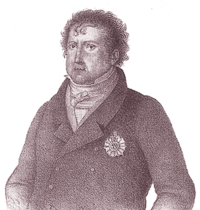João Domingos Bomtempo

João Domingos Bomtempo (Portuguese pronunciation: [ʒuˈɐ̃w̃ duˈmĩɡuʃ bõˈtẽpu]; also Buontempo; Lisbon, December 28, 1775 – Lisbon, August 18, 1842) was a Portuguese classical pianist, composer and pedagogue.
Biography
Bomtempo was the son of an Italian musician in the Portuguese court orchestra, and studied at the Music Seminary of the Patriarchal See in Lisbon. Unlike most of his contemporaries, he was not interested in opera and, in 1801, instead of going to Italy, he traveled to Paris, starting a career as a virtuoso pianist. He moved to London in 1810 and became acquainted with liberal circles. In 1822 he returned to Lisbon, founding a Philharmonic Society to promote public concerts of contemporary music. After the Portuguese civil war between liberals and absolutists, Bomtempo became a music teacher of Queen Maria II of Portugal and first Director of the National Conservatory, created in 1835 to replace the old Patriarchal Seminary, which had been abolished by the liberal régime.
Bomtempo composed a vast amount of concertos (newly published by Soundpost.org), sonatas, variations and fantasies for the piano. His two known symphonies are the first to be produced by a Portuguese composer. Bomtempo's masterpiece is his Requiem in memory of Luís de Camões.
Selected works
Op. 1 \ Piano Sonata No. 1 in F major
Op. 2 \ Piano Concerto No.1 in E flat major (ca. 1804)
Op. 3 \ Piano Concerto No.2 in F minor (ca. 1800-1810)
Op. 4 \ Fandango & Variations for piano
Op. 5 \ Piano Sonata No. 2 in C minor
Op. 6 \ Introduction, 5 variations & fantasy on Paisiello's favorite air for piano
Op. 7 \ Piano Concerto No.3 in G minor
Op. 8 \ Capriccio & Variations on God save the King for piano in E flat major
Op. 9 No.1 \ Piano Sonata No. 3 in E flat major
Op. 9 No.2 \ Piano Sonata No. 4 in C major
Op. 9 No.3 \ Sonata for violin and harpsichord in E major
Op. 10a \ Hymno lusitano (cantata)
Op. 10b \ La Virtù Trionfante (cantata)
Op. 11 \ Symphony No.1 in E flat major
Op. 12 \ Piano Concerto No.4 in D major (1811-1812)
Op. 13 \ Piano Sonata No. 5 in C major
Op. 14 \ Fantasia for piano in C minor
Op. 15 No.1 \ Piano Sonata No. 6 in A flat major
Op. 15 No.2 \ Piano Sonata No. 7 in G minor
Op. 15 No.3 \ Variations for piano on a popular French song
Op. 16 \ Piano Quintet in E flat major
Op. 17 \ A paz da Europa (cantata)
Op. 18 No.1 \ Piano Sonata No. 8 in G major
Op. 18 No.2 \ Piano Sonata No. 9 in F minor
Op. 18 No.3 \ Piano Sonata No.10 in E flat major
Op. 19 \ 12 Studies for piano (1816)
Op. 20 \ Piano Sonata No.11 in E flat major
Op. 21 \ Variations for piano on a theme from Die Zauberflöte in G minor
Op. 22 \ Variations for piano on a theme from Alessandro in Efeso in B flat major
Op. 23 \ Requiem in C minor (1819-1820)
Op. 24 \ Piano Concerto No.5 in C minor/major[1]
- 4 Absolutions
- Libera me Domine in C minor
- Piano Concerto No.6 in E minor (1810-1840)
- Serenata for piano and winds in F major (1821-1830)
- Symphony No.2 in D major
- Te Deum in F major
- Variations for piano on a theme from La donna del Lago in E minor (1822)
- Fantasy for piano and orchestra (on a theme from La donna del Lago)
- Waltz for piano
- Alessandro in Efeso, opera seria
- Tantum Ergo, Kyrie, Gloria e Credo (1842)
- March of Lord Wellington (arrangement by the composer for piano 4-hands)
References
External links
- Free scores by João Domingos Bomtempo at the International Music Score Library Project (IMSLP)
- Tantum Ergo, Kyrie, Gloria e Credo - on-going cooperative transcription in the Wiki-score platform of the score of Bomtempo's last work.
- Bio, Audio Files, List of Works, Links, Bibliography, Discography